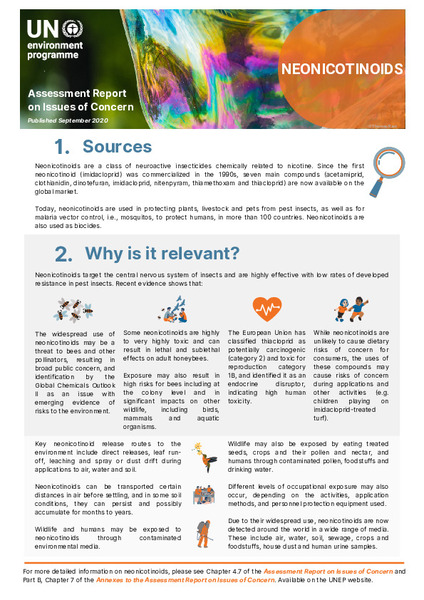| dc.contributor | Economy Division | en_US |
| dc.contributor.author | United Nations Environment Programme | en_US |
| dc.coverage.spatial | Global | en_US |
| dc.date.accessioned | 2022-12-19T19:26:43Z | |
| dc.date.available | 2022-12-19T19:26:43Z | |
| dc.date.issued | 2020-09 | |
| dc.identifier.uri | https://wedocs.unep.org/20.500.11822/41488 | |
| dc.description | Neonicotinoids are a class of neuroactive insecticides chemically related to nicotine. Since the first neonicotinoid (imidacloprid) was commercialized in the 1990s, seven main compounds (acetamiprid, clothianidin, dinotefuran, imidacloprid, nitenpyram, thiamethoxam and thiacloprid) are now available on the global market. Today, neonicotinoids are used in protecting plants, livestock and pets from pest insects, as well as for malaria vector control, i.e., mosquitos, to protect humans, in more than 100 countries. Neonicotinoids are also used as biocides. | en_US |
| dc.description.uri | https://www.unep.org/resources/report/chemicals-and-waste-reports-unea-5 | en_US |
| dc.format | pdf | en_US |
| dc.language | English | en_US |
| dc.relation | An Assessment Report on Issues of Concern: Chemicals and Waste Issues Posing Risks to Human Health and the Environment | en_US |
| dc.relation.ispartof | An Assessment Report on Issues of Concern: Chemicals and Waste Issues Posing Risks to Human Health and the Environment | en_US |
| dc.rights | Public | en_US |
| dc.subject | insecticide | en_US |
| dc.title | Neonicotinoids - Assessment Report on Issues of Concern | en_US |
| wd.identifier.sdg | SDG 3 - Good Health and Well-being | en_US |
| wd.topics | Chemicals and Pollution Action | en_US |
| wd.identifier.pagesnumber | 2 p. | en_US |
| wd.identifier.institutions | United Nations Environment Assembly | en_US |


